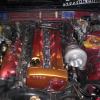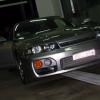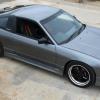more responsive rb20det?
Announcements
-
Similar Content
-
Latest Posts
-
Thanks for all that information I appreciate it. To answer your questions: - Yep that's what I mean. These guys are professional painters to so I must be missing something. It's a bit hard to explain. - With the primer landing on clearcoat, I make sure that the surrounding clearcoat is scuffed to 240 grit as my epoxy primer says that I only need to sand the area to 240 grit. - Yeah so similar to the first question, assuming that the paint landed on the unscuffed clearcoat because I've seen that happen. - Yep I want to prep the surface in that order. Only reason because epoxy primer will protect it from rust and I need that atm with this crappy Sydney weather. I think I was worried about time, if I try to put the filler down but screw it up somehow and I don't have time to sand it off and reapply it then need to put primer later that it might start to rust again so I wanted to apply the primer as quick as possible to not deal with rust. - My car has heaps of small dents, that definitely need filler but are you also sanding the area to 240 grit to fill it in with filler? I always thought you have to go to bare metal for filler to stick but that contradicts the point then that you can put filler on epoxy primer. If you aren't going to bare metal, AND not putting epoxy primer how are you making the dent stick to the paint?
-
I did. I went to a suspension guy and he told me because I don't have adjustable camber arms it's the reason why my car veers towards the left if I take my hands off the wheel but if I drive my other every day car and take my hands off the steering wheel it goes completely straight. I think it's common with Skyline's. In order to fix the problem, I likely need gktech camber arms then nismo bushes since I have poly bushes atm, then a wheel alignment after that. With my car if I take my hands off the steering wheel on a really bumpy road before stopping at a light I have to hold my steering wheel somewhat tight otherwise my car will legit just go completely in the other direction quite quickly and I'll slam into something lol instead of stopping straight. I Believe this YouTuber had the same issue and fixed it with gktech arms. At timestmap 6:05 he talks about how the car doesn't veer anymore after installing these arms.
-
By itsforandres · Posted
hello! does anyone have a schematic that shows how to test the blower motor resistor for the vac system? i believe the part# is 27761-15U00. I think the resistor is toast, but would like to be able to test it somehow before i embark on the journey to find a new one. cheers! 27761-15U00 -
By soviet_merlin · Posted
I don't know the answer to this, but did you have a look at the parts diagrams on amayama.com and see what they list around it for your car? As an example this should be it on my car. That's how I would check for required clips and things like that. But, I take no responsibility for you ending up with a box full of random OEM hoses, washers and clips after going down that path a few times. This definitely has never happened to me -
Most driving should* be done on one side of single lane divided roads. In the RHD world, you drive on the left side of the dividing line and the road is probably cambered equally on both sides. So your side of the road slopes away to the left. The same is true for the LHD world, just everything swapped to the other side and opposite slope. With a perfectly neutral, straight ahead wheel alignment designed to drive straight on a perfectly flat surface (or at least one that is level on the left-right axis, even if it has some slope in the fore-aft axis) you will not be able to drive on a cambered road without the car wanting to drift down the camber. You will need to add steering input in the opposite direction all the time. This is annoying. The solution has always been to set the camber and/or the caster to produce a continuous turning force in the opposite direction of the camber. The car will drive straight on the kind of camber for which it was set up, presumably as described in the top paragraph. But.... when the car is set up this way, as soon as you get into a lane, usually on a multi-lane surface road or highway, where the camber is not as presumed during setup, the car will usually pull to one side. In the RHD world, if you are in the fast lane on a big divided road, you are probably on the opposite camber compared to what the car was set up for (ie, sloping down to the right) and the combination of the setup and that camber will make the car want to go right pretty hard. Even a perfectly flat lane will tend to want to go right. There's no getting around it. Civil engineers who know their stuff (which is not an assumption that can always be made) will attempt to keep the variation in camber across a multi-lane road as small as possible, and if they can will attempt to make the fast lane as close to flat, or even cambered in the same direction as all the other lanes. This takes a lot of planning for drainage, control of levels, ability to deal with the elevation changes that occur at road junctions, etc etc. So it's not trivial to get it right. When they do make it work, then the annoyance is reduced, along with tyre wear, fuel consumption, etc. In theory, the civil engineers are supposed to worry about those aspects of road design also. * This used to be true, but now with very large highway systems, even just multi-lane surface roads running everywhere, it is less true now than it was, but the old assumption is the basis for describing the phenomenon, so let's just run with it for the moment.
-







Recommended Posts
Create an account or sign in to comment
You need to be a member in order to leave a comment
Create an account
Sign up for a new account in our community. It's easy!
Register a new accountSign in
Already have an account? Sign in here.
Sign In Now